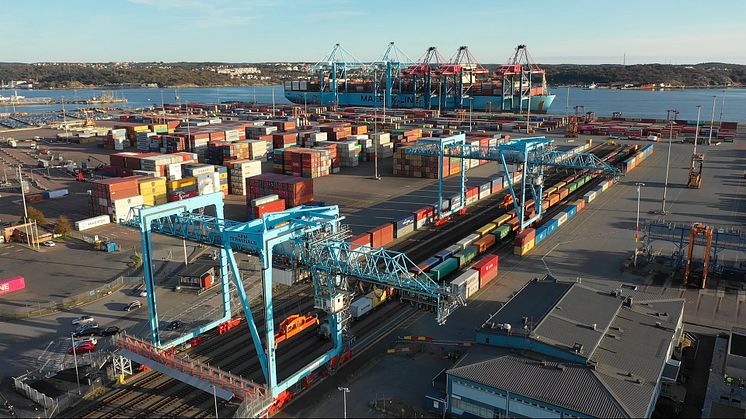
Press release -
All-time high rail traffic boosts Port of Gothenburg container volumes
Newly published Port of Gothenburg freight figures for 2019 showed that container volumes at the Port of Gothenburg rose for the second year in succession. Container freight from the whole of Sweden is being increasingly channelled to the Port of Gothenburg by rail. In total, 456,000 TEU were transported through the port by rail - this is the largest rail volume in the port's 400-year history.
“Growth in rail volumes is reassuring on several levels. The fact that we are the port of Sweden – from north to south – is very obvious. It is also confirmation that our investment in the port’s transshipment potential and rail infrastructure is the right path to follow,” said Elvir Dzanic, Gothenburg Port Authority chief executive.
Container volumes, reported as 20-foot equivalent units (TEUs), rose during 2019 by three per cent to 772,000 units. The past two years have seen a marked increase in container traffic at the Port of Gothenburg. In 2018 growth stemmed mainly from the local catchment area – in 2019 it had the whole of Sweden as its base.
A great deal of long-distance freight for export comprises basic materials used in industry, such as steel, paper, and timber. These are generally transported by rail from inland locations to the Port of Gothenburg for onward transport by container ship to markets on the Continent.
During 2019, 456,000 TEUs passed through the port by rail, up 14 per cent on the previous year. The volume of containerised freight moving into or out of the port by rail rose from an already record-breaking level. The share of quay turnover transported to or from the port by rail is unequalled by any other major international port in the world.
“In 2019, the Port Authority adopted a new environmental goal where the company was set the target of reducing the port’s CO2 emissions throughout the whole of the Gothenburg region by 70 per cent through to 2030. To achieve this goal, the ongoing transition from road to rail is vital,” said Elvir Dzanic.
Through quarter three, the port of Gothenburg increased its share of the Swedish container market by one percent. The figure for the full year has not been established as the total volume for all Swedish ports is not yet available.
Slowdown in intra-European ro-ro volumes
Uncertainty in the European economy was reflected in the port’s intra-European ro-ro volumes, down six per cent on 2018. Prior to that volumes were historically high, reflecting the strong European economy at the time.
More cars during the second half of the year
Handling of new cars at the Port of Gothenburg fell by five per cent to 276,000 units. The downturn can be attributed almost entirely to a decline in imports. Volumes increased during the second half of the year, driven largely by a rise in exports by Volvo Cars.
Downturn and upturn in energy products
As in the automotive segment, the energy segment during the first half of the year was unexceptional. Then came the upturn. Maintenance work at the refinery during the first half of the year and a fall in volume of 7 per cent were followed by a remarkable turnaround. During June-December 12.6 million tonnes of energy products were handled – the highest second-half figure in the company’s history.
Best cruise year ever
Gothenburg has never been as popular as a cruise destination than in 2019. More than 110,000 cruise passengers on 60 cruise ships visited Gothenburg – an all-time high. And there is every reason to be optimistic about the future. With 83 calls already scheduled for 2020, it is set to become yet another record-breaking year.
Port of Gothenburg freight volumes 2019
| Jan-dec 2019 | Jan-dec 2018 | Change % Jan-dec | |
| Containers, TEU | 772,000 | 753,000 | 3% |
| Rail, TEU | 456,000 | 398,000 | 14% |
| Ro-ro units | 551,000 | 584,000 | -6% |
| New cars | 276,000 | 290,000 | -5% |
| Passengers (ferry) | 1,784,000 | 1,685,000 | 6% |
| Cruise ship calls | 59 | 43 | 37% |
| Energy products, m tonnes | 22,2 | 23,4 | -5% |
| Total, m tonnes | 38,9 | 40,5 | -4% |
Topics
Fact file: Port of Gothenburg
The Port of Gothenburg is the largest port in the Nordic region. 30 per cent of Swedish foreign trade passes through the Port of Gothenburg as well as half of all container traffic.
The Port of Gothenburg is the only port in Sweden with the capacity to receive the world's largest container vessels and has the broadest range of shipping routes within and outside Europe. The 25 rail shuttles that depart each day mean that companies throughout Sweden and Norway have a direct, environmentally smart link to the largest port in the Nordic region. The Port of Gothenburg has terminals for oil, cars, ro-ro, containers and passengers.


